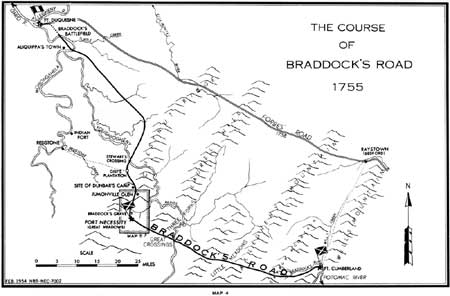|
FORT NECESSITY National Battlefield |
 |

(click on image for an enlargement in a new window)
The Braddock Expedition (continued)
THE FRENCH PREPARE FOR ACTION. Governor General Duquesne had learned of the overall campaign plans of the British, and he likewise knew that Braddock's two regiments had sailed from Britain. In a countermove, the French Government prepared to send a strong contingent of its best troops to defend French strongholds in the New World. It soon became apparent, however, that the French force would not reach Quebec before the British troops had landed in Virginia and were well on the way toward the Ohio.
Thus, as the crisis for the French at Fort Duquesne approached, the garrison consisted of hardly more than 1,000 Frenchmen and Indians, the latter including small parties from many tribes of the Ohio and Great Lakes country, and the Shawnee, a strong nation, which had now turned against the English. The pressure brought by the British against Fort Beausejour in Nova Scotia, Fort St. Frederic at Crown Point, and at Forts Niagara and Frontenac forced the new Governor General, the Marquis de Vaudreil, who arrived in Quebec on June 26, to divide his forces for the defense of these points. Contrecoeur's command at Fort Duquesne was thus assigned to man its own defenses against Braddock's powerful army.
On July 8, the French at Fort Duquesne were thrown into great confusion by reports from scouts that Braddock's army was just beyond the Monongahela. Contrecoeur, upon the suggestion of either Capt. Lienard de Beaujeu or Capt. Jean-Daniel Dumas, resolved to meet the enemy on the march and to ambush them. The crossing of the Monongahela, 8 miles away, appeared to offer the best conditions for a surprise attack. Early on the morning of July 9, final preparations were hurriedly made, and, with Beaujeu in command, the party of 250 French and 650 Indians, many of whom had drifted off only to return as the fight began, started over the well-beaten path toward Turtle Creek.

|
|
Last Modified: Mon, Dec 2 2002 10:00:00 am PDT |


